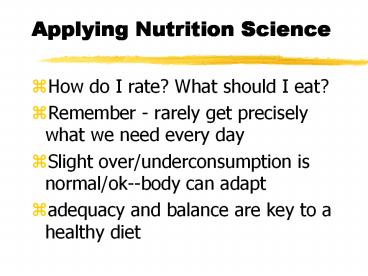Applying Nutrition Science - PowerPoint PPT Presentation
1 / 15
Title:
Applying Nutrition Science
Description:
Dietary Stds.,Guidelines, Recommendations. Dietary Reference Intakes ... The Unified Dietary Guidelines. Eat at least 6 servings of whole grain foods each day. ... – PowerPoint PPT presentation
Number of Views:57
Avg rating:3.0/5.0
Title: Applying Nutrition Science
1
Applying Nutrition Science
- How do I rate? What should I eat?
- Remember - rarely get precisely what we need
every day - Slight over/underconsumption is normal/ok--body
can adapt - adequacy and balance are key to a healthy diet
2
Food Choices
- Can affect our nutritional status
- What do we eat/why?
- Availability
- Economics
- Education/ Lifestyle
3
Food Choices
- Health/ Physiology
- Sociocultural Factors
- Attitudes/ Beliefs
4
Assessing Nutritional Status
- Am I eating a healthy diet?
- How do I rate?
- Need to evaluate the body and the diet
- Body
- Laboratory Tests
- Anthropometric Measures
5
(No Transcript)
6
Assessing Nutritional Status (continued)
- Diet
- 24 hour recall
- note
- person might not remember accurately
- day-to-day variation
7
Assessing Nutritional Status (continued)
- Food Record/Diary
- write down what is eaten as it is eaten
- may record and average several days
- Food Frequency/Diet History
8
Dietary Stds.,Guidelines, Recommendations
- Dietary Reference Intakes
- take into consideration health promotion and
reduction of chronic disease as well as
prevention of deficiencies - multiple reference values
- grouped by gender, age, life stages
9
Dietary Reference Intakes, cont.
- Include
- Estimated Average Requirement--amount estimated
to meet needs of 50 of population - Recommended Dietary allowances-- levels of intake
believed to meet the needs of most (98) healthy
individuals in each group
10
Dietary Reference Intakes, cont.
- Adequate Intakes--estimates made when there is
insufficient scientific evidence to establish EAR
and RDA - Tolerable Upper Intake Levels--maximum daily
intake level unlikely to pose risks
11
The Unified Dietary Guidelines
12
The Unified Dietary Guidelines
- Eat a variety of foods.
- Choose most foods from plant sources.
- Eat at least 5 servings of fruits and vegetables
every day.
13
The Unified Dietary Guidelines
- Eat at least 6 servings of whole grain foods each
day. - Minimize the consumption of high-fat foods,
especially those from animals. - Choose low-fat, low-cholesterol foods.
- Limit the amount of simple sugars in the diet.
14
Dietary Stds.,Guidelines, Recommendations
- Food Guide Pyramid
- 6 food groups
- grains fruit vegetable
- meat dairy other
- relative size on pyramid relates to the suggested
number of servings - try to select foods of high nutrient density
15
(No Transcript)






![[READ]✔️ Williams' Essentials of Nutrition and Diet Therapy (Williams' PowerPoint PPT Presentation](https://s3.amazonaws.com/images.powershow.com/10076454.th0.jpg?_=20240710116)
























